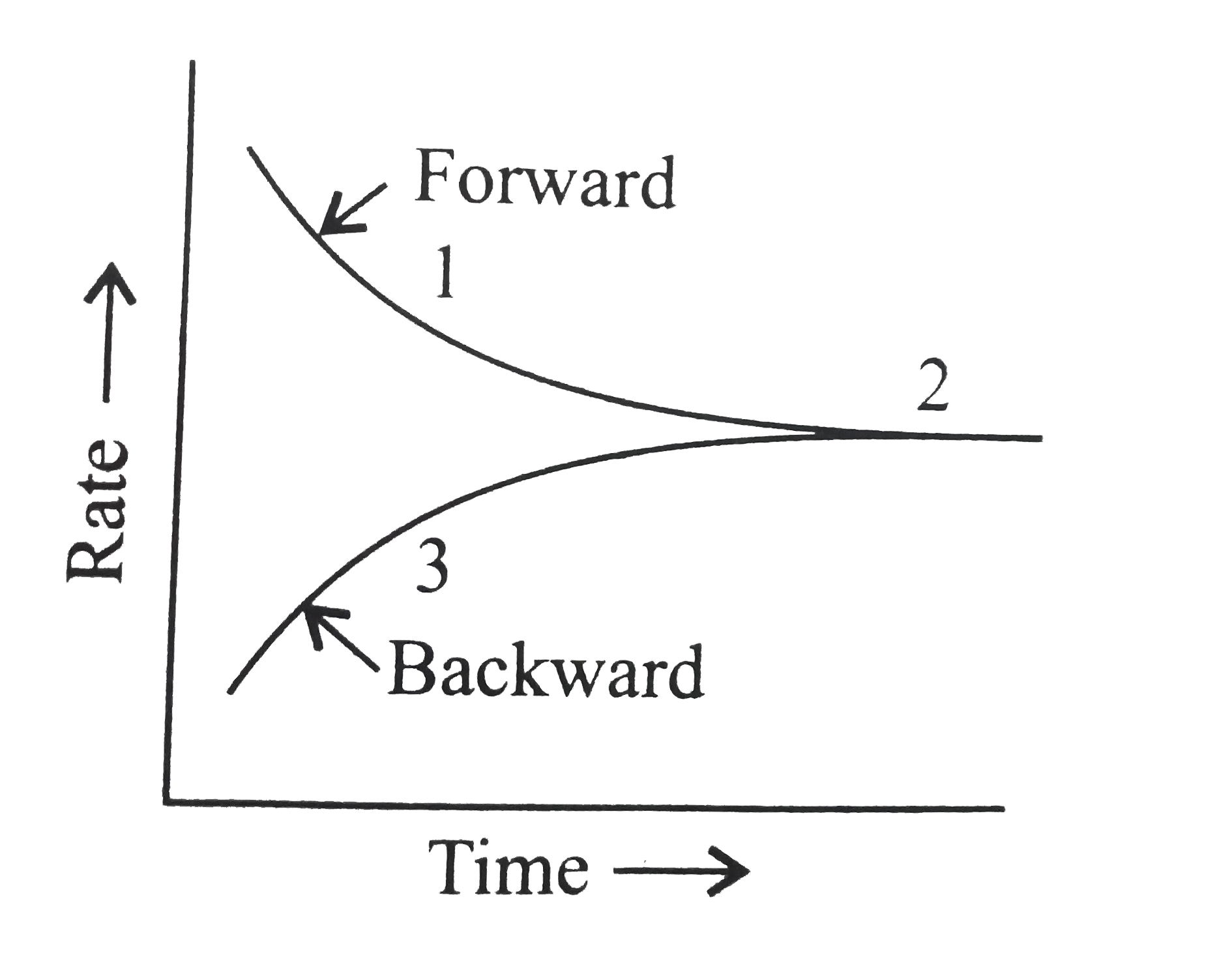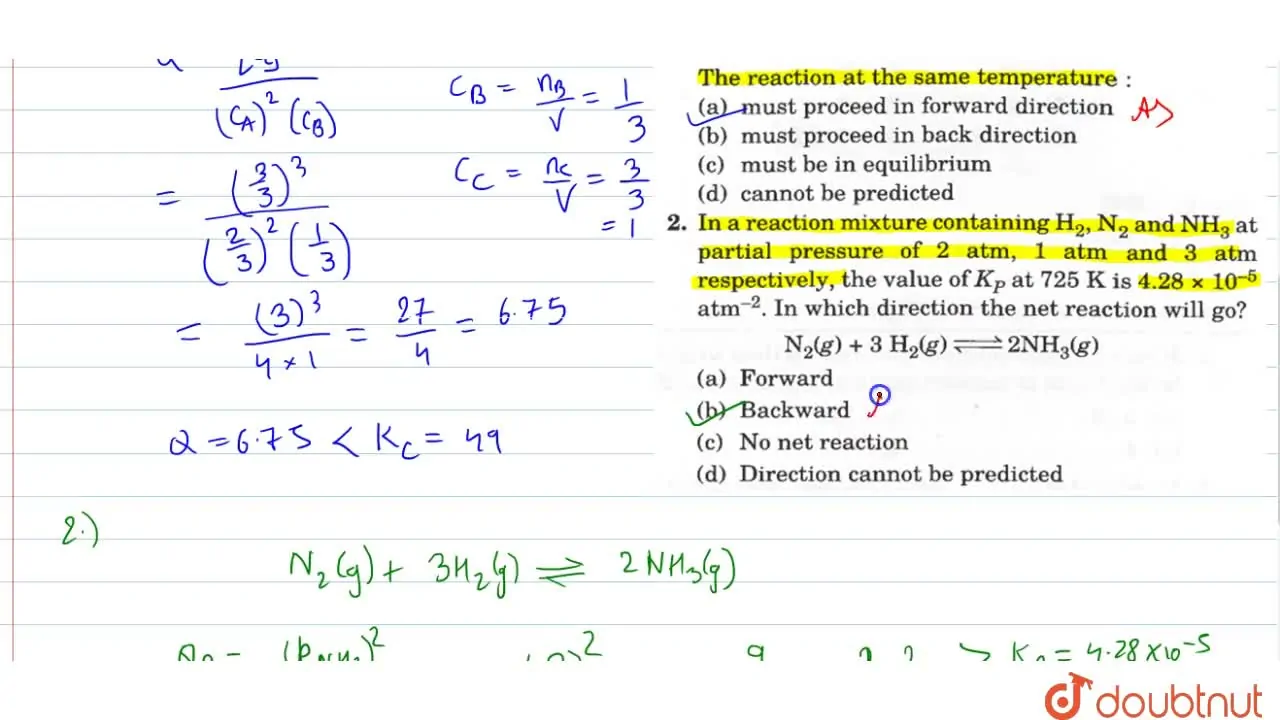Mass action ratio or reaction quotient Q for a reaction can be calculated using the law of mass actionl,
A(g)+B(g)⇔C(g)+D(g)
Q=[C][D][A][B]
The value of Q decides whether the reaction is at equilibrium or not.
At equilibrium, Q=K
For non-equilibrium process Q≠K
When Q>K, reaction will be favoured in backward direction and when Q<K, it will be favoured in forward direction. For the reaction : 2A+B⇔3C at 298 K, Kc=49 A 3 L vessel contains 2, 1 and 3 moles of A, B and C respectively. The reaction at the same temperature :
must proceed in forward direction.
must proceed in back direction
must be predicted
cannot be predicted
The correct Answer is:A
Step by step video, text & image solution for Mass action ratio or reaction quotient Q for a reaction can be calculated using the law of mass actionl, A(g)+B(g)hArrC(g)+D(g) Q=([C][D])/([A][B]) The value of Q decides whether the reaction is at equilibrium or not. At equilibrium, Q=K For non-equilibrium process QneK When QgtK, reaction will be favoured in backward direction and when QltK, it will be favoured in forward direction. For the reaction : 2A+BhArr3C at 298 K, K_(c)=49 A 3 L vessel contains 2, 1 and 3 moles of A, B and C respectively. The reaction at the same temperature : by Chemistry experts to help you in doubts & scoring excellent marks in Class 11 exams.
Similar Questions
Mass action rato or reaction quotient Q for a reaction can be calculate using the law of masss action
A(g)+B(g)⇔C(g)+D(g)
Q=[C][D][A][B]
The value of Q decides whether the reaction is at equilibrium or not.
At equilibrium, Q=K
For an equilibrium process, Q≠K
when Q>K, reaction will favour backward direction and when Q<K, it will favour direction.
Answer the following questions:
For the reaction:
2A+B⇔3C at 298K,Kc=40
A 4L vessel contains 2,1, and 4 mol of A, B and c, respectively. The reaction at the same temperatureView SolutionMass action ratio or reaction quotient Q for a reaction can be calculated using the law of mass actionl,
A(g)+B(g)⇔C(g)+D(g)
Q=[C][D][A][B]
The value of Q decides whether the reaction is at equilibrium or not.
At equilibrium, Q=K
For non-equilibrium process Q≠K
When Q>K, reaction will be favoured in backward direction and when Q<K, it will be favoured in forward direction. In a reaction mixture containing H2,N2 and NH3 at partial pressure of 2 atm, 1 atm and 3 atm respectively, the value of Kp at 725 K is 4.28×10−5 atm−2. In which direction the net reaction will go ?
N2(g)+3H2(g)⇔2NH3(g)View SolutionMass action ratio or reaction quotient Q for a reaction can be calculated using the law of mass actionl,
A(g)+B(g)⇔C(g)+D(g)
Q=[C][D][A][B]
The value of Q decides whether the reaction is at equilibrium or not.
At equilibrium, Q=K
For non-equilibrium process Q≠K
When Q>K, reaction will be favoured in backward direction and when Q<K, it will be favoured in forward direction.
In the following reaction :
2SO2(g)+O2(g)⇔2SO3(g)
The equilibrium is not attained. The rate of forward reaction is greater than that of backward reaction. Thus, which of the following is the correct relation between Kp and Qp?View SolutionMass action rato or reaction quotient Q for a reaction can be calculate using the law of masss action
A(g)+B(g)⇔C(g)+D(g)
Q=[C][D][A][B]
The value of Q decides whether the reaction is at equilibrium or not.
At equilibrium, Q=K
For an equilibrium process, Q≠K
when Q>K, reaction will favour backward direction and when Q<K, it will favour direction.
Answer the following questions:
In a reaction mixture containing H2,N2 and NH3 at partial pressure of 2 atm, 1 atm and 3 atm respectively, the value of Kp at 700K is 4.00×10−5atm−2. In which direction the net reaction will go?
N2(g)+3H2(g)⇔2NH3(g)View SolutionMass action rato or reaction quotient Q for a reaction can be calculate using the law of masss action
A(g)+B(g)⇔C(g)+D(g)
Q=[C][D][A][B]
The value of Q decides whether the reaction is at equilibrium or not.
At equilibrium, Q=K
For an equilibrium process, Q≠K
when Q>K, reaction will favour backward direction and when Q<K, it will favour direction.
Answer the following questions:
In the following reaction:
2SO2(g)+O2(g)⇔2SO3(g)
the equilibrium is not attained. The rate of forward reaction is greater than that of backward reaction. Thus, which of the following is the correct relation between Kp and Qp?View SolutionMass action rato or reaction quotient Q for a reaction can be calculate using the law of masss action
A(g)+B(g)⇔C(g)+D(g)
Q=[C][D][A][B]
The value of Q decides whether the reaction is at equilibrium or not.
At equilibrium, Q=K
For an equilibrium process, Q≠K
when Q>K, reaction will favour backward direction and when Q<K, it will favour direction.
Answer the following questions:
In the reaction:
NH4Cl(g)⇔NH3(g)+HCl(g)
a graph is plotted to show that the variation or the rate of forward and backward reaction against time.
Which of following is correct?
 View Solution
View SolutionMass action rato or reaction quotient Q for a reaction can be calculate using the law of masss action
A(g)+B(g)⇔C(g)+D(g)
Q=[C][D][A][B]
The value of Q decides whether the reaction is at equilibrium or not.
At equilibrium, Q=K
For an equilibrium process, Q≠K
when Q>K, reaction will favour backward direction and when Q<K, it will favour direction.
Answer the following questions:
The reaction quotient Q for:
O2(g)+2H2(g)⇔2H2O(g)
is given by Q=[H2O]2[O2][H2]2. The reaction will proceed in backward direction, whenView SolutionThe reaction quotient (Q) at equilibrium is
View SolutionTwo moles of each reactant A and B are taken in a reaction flask. They react in the following manner,
A(g)+B(g)⇔C(g)+D(g)
At equilibrium, it was found that the concentration of C is triple to that of B the equilibrium constant for the reaction isView SolutionFor a reaction A(g)+B(g)⇔C(g)+D(g) the intial concentration of A and B are equals but the equilibrium constant of C is twice that of equilibrium concentration of A. Then K is
View Solution


